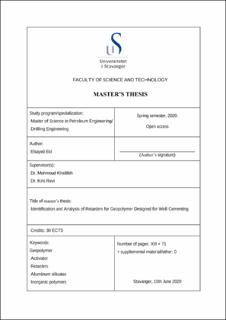| dc.description.abstract | Ordinary Portland cement (OPC) is the primary material, which is used in oil well cement, isolation formation and plug and abandonment. OPC has many advantages and some limitations reviewed by different authors. The limitations associated with cement cause well integrity issues, risking humans, and environment. Several studies and experiments are conducted to evaluate different materials, which could be an optimal alternate to OPC. Geopolymer is one of these materials, which has been tested in lab scale to find its potential to replace OPC. Geopolymers are inorganic materials based on rock sources, which are rich in aluminum silicates. Many pieces of research have conducted on the geopolymer to assess its characteristics and properties. Studies showed that geopolymer is a ductile and low shrinkage material. It develops sufficient bond strength, high compressive strength and less fluid loss comparing to OPC. However, studies showed some shortcomings of geopolymer, which should be enhanced to allow using the geopolymer in the oil field. The pumpability at elevated temperatures, for a certain period, is one of the current limitations of the geopolymer. Several experiments have been performed to get the proper compositions of the geopolymer and the appropriate retarding admixture, which help to increase the pumping time of the geopolymer paste. Chemical S&H revealed its potential to retard the setting time by 80 mins. It is proved that there many parameters, which control the setting time of the sample. The modular ratio, weight of the admixture and composition of the precursors, have an impact on delaying the thickening time. BS2 is more pumpability than BS1, and S7 is the sample which has the most significant pumping time among the others. Results from the uniaxial compressive test (UCS) and ultrasonic cement analyzer (UCA) show the compressive strength value is in an acceptable range for utilization in oil well cementing. Rheology properties of geopolymers were characterized as non-Newtonian shearthinning fluid and its density within the permissible range (1.95 sg). These characteristics promote the geopolymer to be a good quality alternative material to be applied in downhole applications. | en_US |
